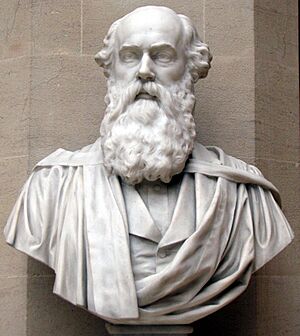Henry John Stephen Smith facts for kids
Quick facts for kids
Henry John Stephen Smith
|
|
|---|---|
 |
|
| Born | 2 November 1826 |
| Died | 9 February 1883 (aged 56) |
| Resting place | St Sepulchre's Cemetery, Oxford |
| Alma mater | Balliol College, Oxford |
| Known for | Smith–Minkowski–Siegel mass formula Smith normal form Smith–Volterra–Cantor set |
| Scientific career | |
| Fields | Mathematics |
| Institutions | University of Oxford |
Henry John Stephen Smith (born November 2, 1826 – died February 9, 1883) was an Irish mathematician. He was also an amateur astronomer. Smith is known for his important work in number theory, which is a branch of mathematics.
He studied things like elementary divisors and quadratic forms. You might also hear his name linked to the Smith normal form in matrix theory. This is a special way to simplify matrices. Smith was also the first to discover a mathematical idea similar to the Cantor set.
Contents
Life Story: Henry Smith's Journey
Early Life and Education
Henry Smith was born in Dublin, Ireland. He was the fourth child in his family. Sadly, his father, John Smith, passed away when Henry was only two years old. His mother, Mary Murphy, soon moved the family to England.
Henry had many brothers and sisters, thirteen in total! One of his sisters, Eleanor Smith, became a well-known activist for education. Henry's mother taught him at home until he was 11. After that, private teachers helped him learn.
When he was 15, in 1841, Henry went to Rugby School in Warwickshire. This happened because his tutor, Henry Highton, became a teacher there.
University Years and Beyond
At 19, Henry won a scholarship to Balliol College, Oxford. He finished his studies in 1849 with top grades in both mathematics and classics. Henry was very good at French. He spent holidays in France and even took math classes in Paris.
He lived with his mother until she passed away in 1857. After that, his sister Eleanor came to live with him.

After graduating, Smith stayed at Balliol College. He worked there as a math tutor. Soon, he became a Fellow of the college.
In 1861, he became the Savilian Chair of Geometry at Oxford. This is a very important teaching position. Later, in 1873, he received a special fellowship at Corpus Christi College, Oxford. This allowed him to stop teaching at Balliol.
In 1874, he became the Keeper of the University Museum. He and his sister moved into the Keeper's House in Oxford.
Busy Life and Legacy
Henry Smith was very good at managing things. Because of this, he was often asked to help with important academic tasks. He was the Keeper of the Oxford University Museum. He also helped examine math students for the University of London.
He was part of a special group that looked at how science was taught. He also helped change how the University of Oxford was run. Smith was the head of a committee that watched over the Meteorological Office. He was even president of the London Mathematical Society twice!
Henry Smith passed away in Oxford on February 9, 1883. He is buried in St Sepulchre's Cemetery in Oxford.
What Did Henry Smith Study?
Exploring Numbers
Henry Smith's first math papers were about shapes and geometry. But his third paper was about the theory of numbers. This is a field that studies whole numbers and their properties.
He wrote one paper in Latin, proving a theorem by Fermat. This theorem says that certain prime numbers can be written as the sum of two square numbers. He also wrote an introduction to number theory.
In 1858, a group called the British Association asked Smith to write a report on number theory. He worked on this report for many years, from 1859 to 1865. In it, he clearly explained the work of other mathematicians. He often added his own new ideas too.
While working on this report, Smith made many new discoveries in number theory. Some of his findings were published in important science journals. He solved a problem posed by another mathematician, Eisenstein. This problem was about breaking down numbers into the sum of five squares. He also looked at similar problems for seven squares.
A Famous Math Prize
In 1868, Smith went back to studying geometry. He won the Steiner prize from the Royal Academy of Sciences of Berlin for his work on certain math problems.
In 1882, Smith was surprised to see that the Paris Academy of Science was offering a big prize. The prize was for solving the problem of breaking down numbers into a sum of five squares. The Academy mentioned Eisenstein's work but not Smith's!
Smith had already published his own work on this topic. He wrote to a mathematician named M. Hermite, who told him to submit his work for the prize. Smith quickly finished his detailed proofs.
Two months after Smith passed away, the Paris Academy announced the winners. Two papers were chosen for the prize. When the winners' names were revealed, they were Henry Smith and Minkowski. Minkowski was a young mathematician from Prussia. It turned out that the judges didn't know about Smith's earlier work on the subject.
Understanding Functions
In 1875, Smith published another important paper. This one was about how to "integrate" certain kinds of functions. He gave clear definitions and proofs for ideas that another mathematician, Riemann, had worked on.
Smith also showed an example of a special set of numbers. This set is called the Smith–Volterra–Cantor set. It's a very interesting example in mathematics because it's "nowhere-dense" but still has a "positive measure." This means it's full of gaps but still takes up some space on the number line.
See also
- Smith–Volterra–Cantor set

